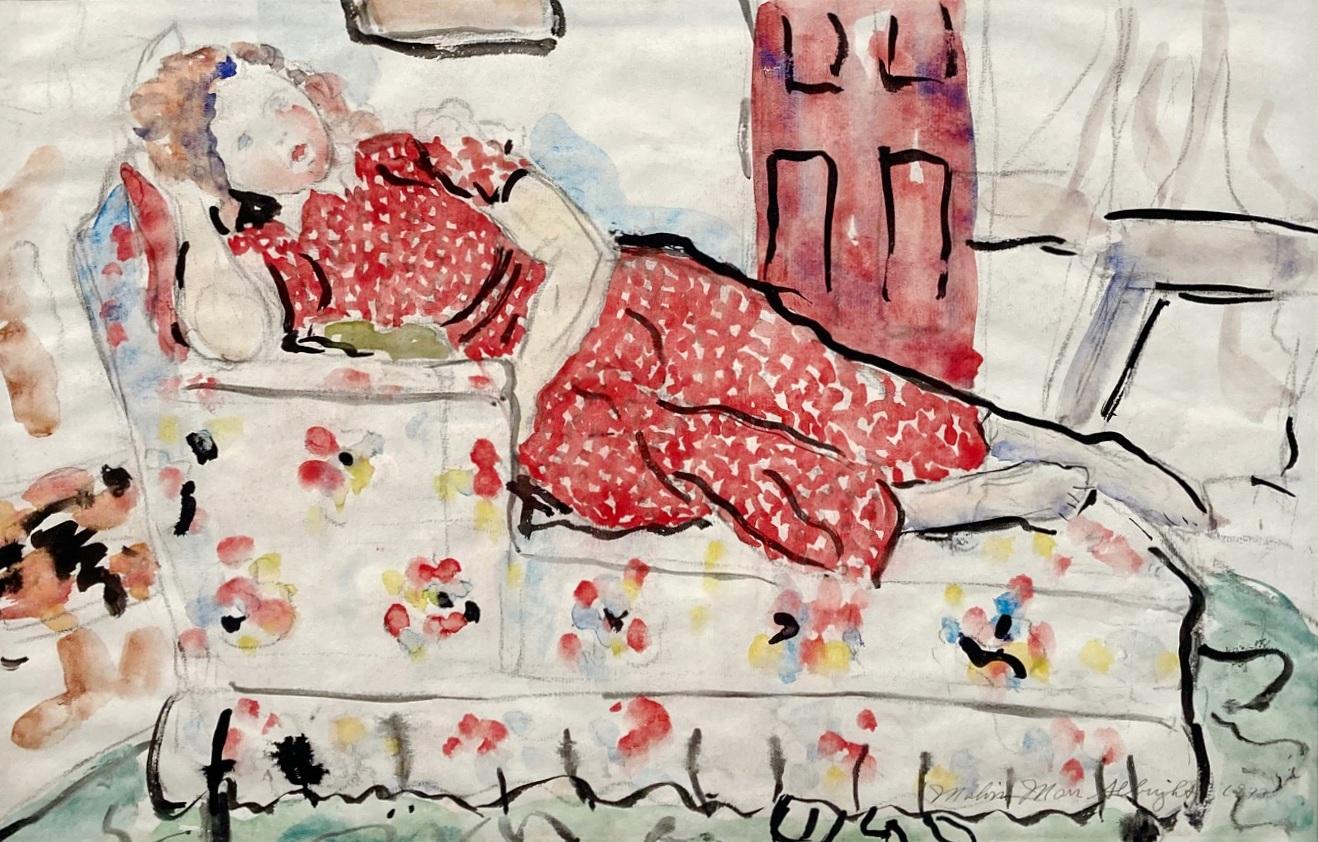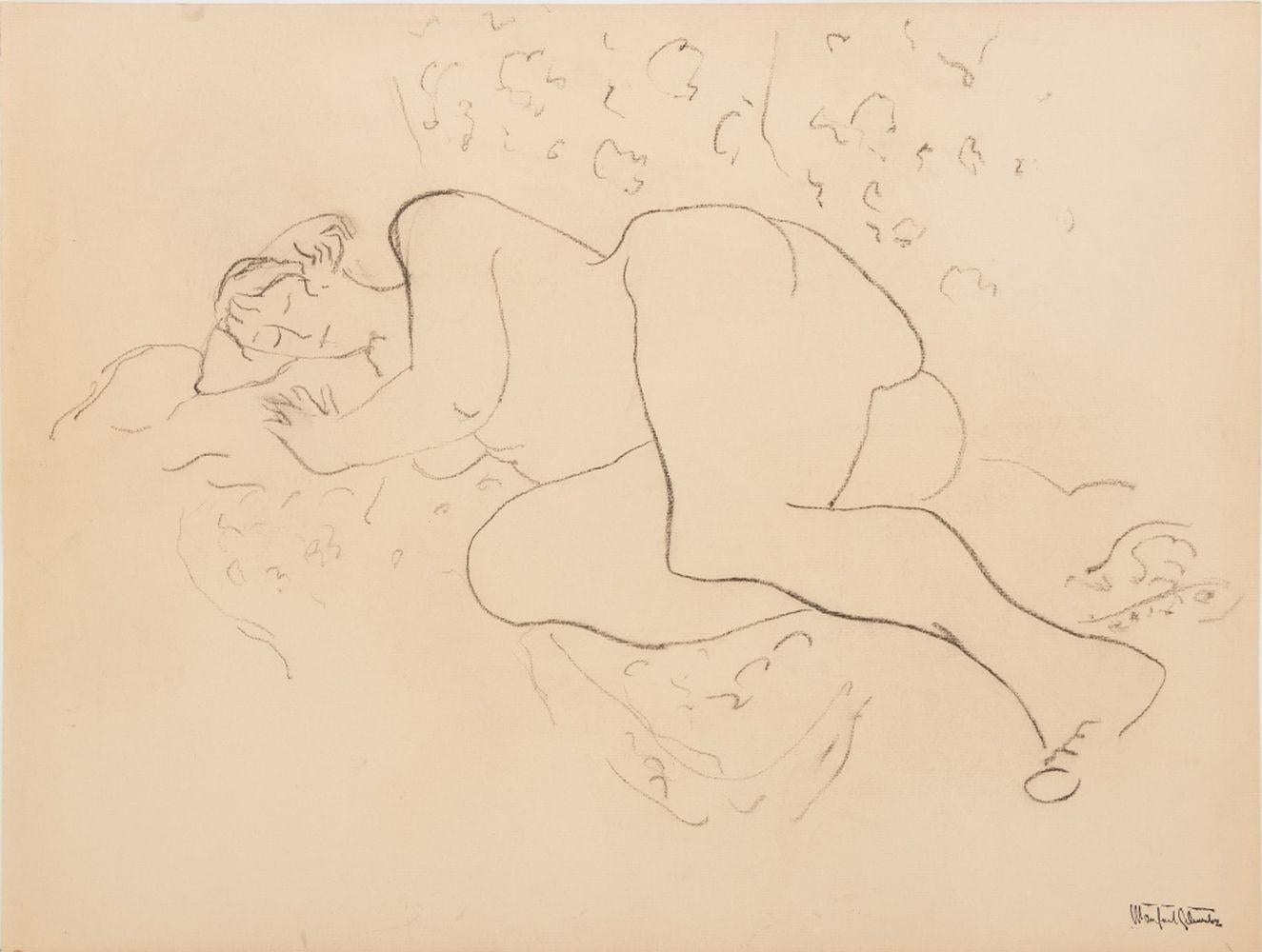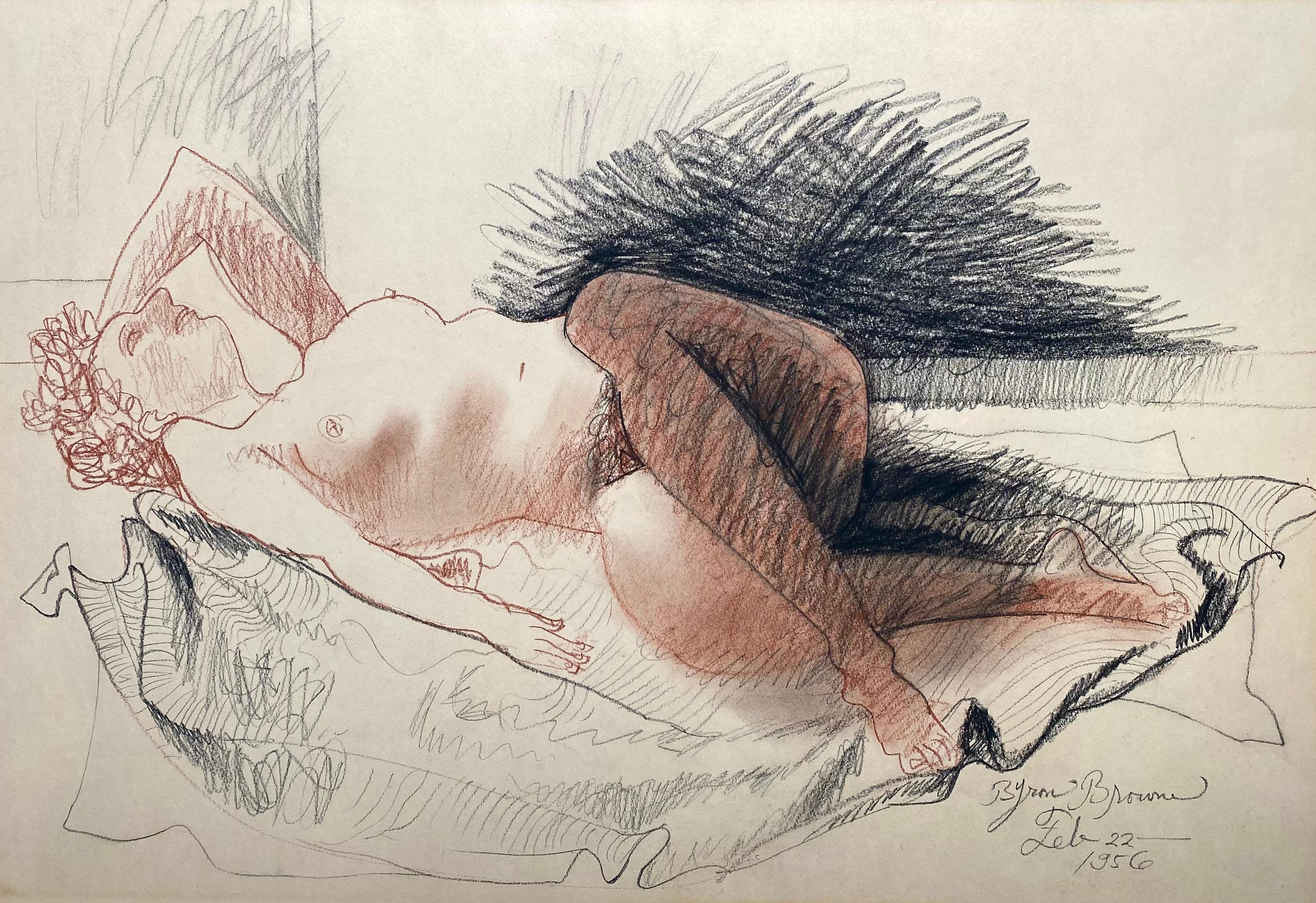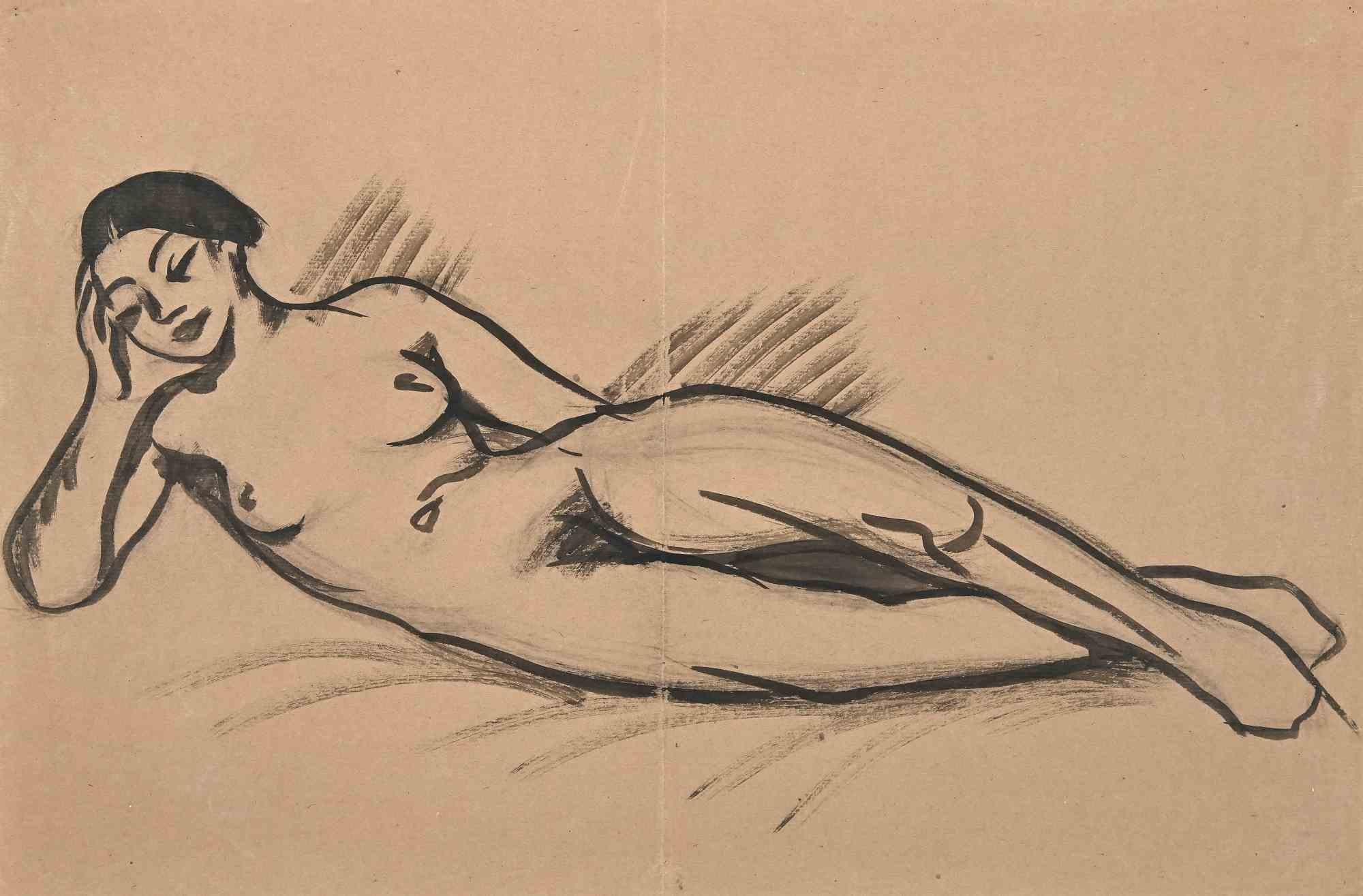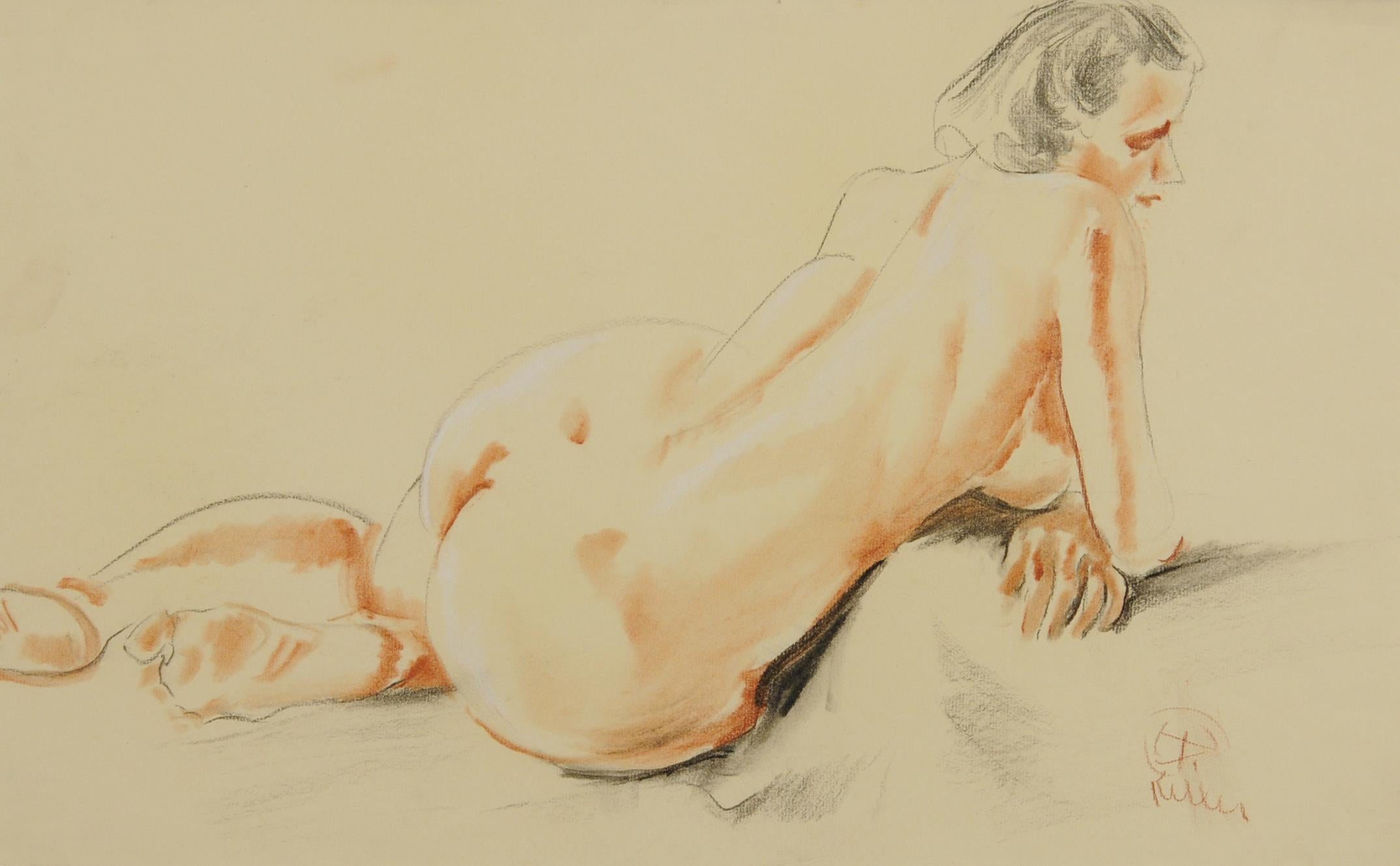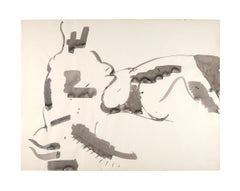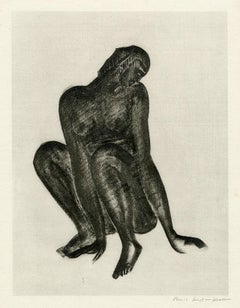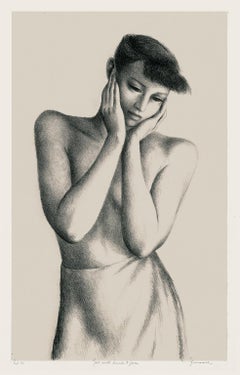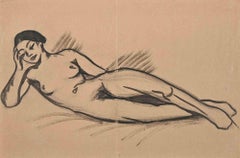Items Similar to Colored Drawing No. 6 (Reclining Woman)
Want more images or videos?
Request additional images or videos from the seller
1 of 3
Konrad CramerColored Drawing No. 6 (Reclining Woman)1931
1931
$900
£683.57
€789.75
CA$1,261.38
A$1,411.72
CHF 736.81
MX$17,215.76
NOK 9,430.19
SEK 8,926.88
DKK 5,893.81
Shipping
Retrieving quote...The 1stDibs Promise:
Authenticity Guarantee,
Money-Back Guarantee,
24-Hour Cancellation
About the Item
Konrad Cramer, 'Colored Drawing No. 6' (Reclining Woman), monotype, 1931. Signed and dated in pencil beneath the image, lower right. Annotated 'Colored D' (drawing), No 6' in pencil, lower left sheet corner.
A fine, spontaneous work, on cream laid paper, with full margins (1 1/8 to 1 3/4 inches); original brown paper hinges in the top left and right sheet corners, in excellent condition. Image size 5 3/8 x 10 7/8 inches; sheet size 8 1/2 x 13 7/8 inches. Matted to museum standards, unframed.
A monotype is the printmaking technique of drawing or painting on a smooth, non-absorbent surface. The surface or matrix can vary from a copper etching plate, zinc, or glass to acrylic. The image is then transferred onto a sheet of paper by pressing the two together, usually using a printing-press. The inks used may be oil-based or water-based. Monotyping produces a unique print or monotype as most of the ink is removed during the initial pressing. Monotypes are typically executed, with no initial sketch resulting in a spontaneous, gestural image.
ABOUT THE ARTIST
Konrad Cramer (1882-1963), one of America's earliest modernist painters, was a founder and director of the renowned Woodstock Artists Association and the Woodstock School of Painting.
Born in Wurtzburg, Germany, Cramer was initially influenced by the Munich expressionist ‘Blaue Reiter’ (Blue Rider) movement founded by Wassily Kandinsky. He was further inspired by Cezanne's ‘planes of light’, incorporating a Cubist idiom into his work.
In 1911, he married an American art student and moved to New York, where he established his reputation two years later with a pioneering series of abstract paintings. His post World War I work rendered the everyday objects of American culture with he personal blend of European modernism.
Dividing his time between Woodstock and Manhattan, he became prominent in progressive art circles. His close friendship with Alfred Stieglitz provoked his interest in photography, which led to his directing and teaching at The Woodstock School of Miniature Photography.
Cramer first exhibited at the Whitney Studio Club in 1924 and participated in the Whitney Museum of American Art's first and second biennials in 1933 and 1935. He was also included in the 1935 exhibition Abstract Painting in America at the Whitney. Cramer was later included in the Whitney Museum exhibition ‘Pioneers of Modern Art in America’ in 1946. In 1930 he shared a two-person exhibition at the Dudensing Gallery in Manhattan with Adolph Gottlieb. Throughout the 1930s, Cramer participated in many other museum invitationals, including Carnegie International (1929, 1933, 1937, 1938); Pennsylvania Academy of the Fine Arts (1934, 1936), and Corcoran Gallery of Art (1935, 1937). He also exhibited at the Woodstock Art Association, Society of Independent Artists (New York), Art Institute of Chicago. Solo exhibitions of his work were held at Club Latin in Cincinnati (1932), the State University of New York at New Paltz (1952), the Woodstock Guild of Craftsman (1956), and Long Island University (1958).
Cramer’s work is held in public collections across the country, including the Flint Institute of Art, Heckscher Museum of Art, Los Angeles County Museum of Art, Metropolitan Museum of Art, San Diego Museum of Art, National Gallery of Art, Smithsonian American Art Museum, University of North Carolina, Whitney Museum of American Art, Woodstock Artists Association.
- Creator:Konrad Cramer (1888-1963, German)
- Creation Year:1931
- Dimensions:Height: 5.38 in (13.67 cm)Width: 10.88 in (27.64 cm)
- Medium:
- Movement & Style:
- Period:
- Condition:
- Gallery Location:Myrtle Beach, SC
- Reference Number:Seller: 1027131stDibs: LU53236842742
About the Seller
5.0
Recognized Seller
These prestigious sellers are industry leaders and represent the highest echelon for item quality and design.
Platinum Seller
Premium sellers with a 4.7+ rating and 24-hour response times
Established in 1995
1stDibs seller since 2016
308 sales on 1stDibs
Typical response time: 1 hour
Associations
International Fine Print Dealers Association
- ShippingRetrieving quote...Shipping from: Myrtle Beach, SC
- Return Policy
Authenticity Guarantee
In the unlikely event there’s an issue with an item’s authenticity, contact us within 1 year for a full refund. DetailsMoney-Back Guarantee
If your item is not as described, is damaged in transit, or does not arrive, contact us within 7 days for a full refund. Details24-Hour Cancellation
You have a 24-hour grace period in which to reconsider your purchase, with no questions asked.Vetted Professional Sellers
Our world-class sellers must adhere to strict standards for service and quality, maintaining the integrity of our listings.Price-Match Guarantee
If you find that a seller listed the same item for a lower price elsewhere, we’ll match it.Trusted Global Delivery
Our best-in-class carrier network provides specialized shipping options worldwide, including custom delivery.More From This Seller
View AllReclining Nude — Mid-Century Modernism, Renowned African American Artist
Located in Myrtle Beach, SC
Robert Blackburn, Untitled (Reclining Nude), brush and ink, c. 1948, unsigned. A fine, spontaneous work, on cream wove paper. Slight toning to the sheet edges; otherwise in excellent condition. Matted to museum standards, unframed.
Image size 18 3/4 x 23 1/2 inches (476 x 597 mm).
Provenance: Adrienne E. Wheeler Collection, acquired from the artist.
ABOUT THE ARTIST
Robert Blackburn (1920 - 2003) participated in the rich mix of art programs and creative groups available in Harlem as he grew up, including Charles Alston's Harlem Arts Workshop, the Harlem YMCA, and later the Harlem Artist's Guild. In 1937 he joined the WPA at the Harlem Community Art Center, the largest New York center for instruction in the arts. There he was exposed to Harlem's most prominent artists, Aaron Douglas, William Henry Johnson...
Category
1940s American Modern Drawings and Watercolor Paintings
Materials
Ink
Untitled (Figurative Abstraction of Isadora Duncan #7)
By Abraham Walkowitz
Located in Myrtle Beach, SC
Abraham Walkowitz, Untitled (Figurative Abstraction of Isadora Duncan #7), pencil, 1918. Signed and dated in pencil, bottom center. A fine, spon...
Category
1910s American Modern Figurative Drawings and Watercolors
Materials
Pencil
Untitled (Black Woman Crouching)
By Boris Lovet-Lorski
Located in Myrtle Beach, SC
Boris Lovet-Lorski, 'Untitled (Black Woman Crouching)', lithograph, edition 250, 1929. Signed and numbered 16 in pencil. Number 16 of Volume 2, a series of...
Category
1920s Art Deco Nude Prints
Materials
Lithograph
'Girl with Hands to Face' — Mid-century Modernism
By Benton Murdoch Spruance
Located in Myrtle Beach, SC
Benton Spruance, 'Girl with Hands to Face', two-color lithograph, 1940, edition 30, Fine and Looney 180. Signed, titled, and annotated 'Ed. 30' in pencil. A superb impression, on cr...
Category
1940s American Modern Figurative Prints
Materials
Lithograph
$960 Sale Price
20% Off
'Girl and Cat' — 1930s American Modernism
By Benton Murdoch Spruance
Located in Myrtle Beach, SC
'Girl and Cat', lithograph, 1935, edition 33, Fine and Looney 121. Signed, titled, dated, and numbered '5/33' in pencil. A superb, richly-inked impression...
Category
1930s American Modern Figurative Prints
Materials
Lithograph
Untitled (Seated Nude) — Black Woman Artist
Located in Myrtle Beach, SC
Ann Graves Tanksley, Untitled (Seated Nude), oil and marker, 1984. Signed and dated, lower right. A fine, expressionist rendering, with fresh colors, on cream wove paper, painted to the sheet edges, in excellent condition. Archivally matted to museum standards, unframed.
Image size/sheet size: 24 1/16 x 18 inches (611 x 457 mm).
ABOUT THE ARTIST
“Her work reflects the influence of her travels, the residential colors, the simple work habits, the loneliness, and the love and devotion to one’s spiritual beliefs. There is a oneness of artist and concept. Her love of life, despite social barriers and frustrations, is promoted in her work for audiences to witness and accept... Her paintings evoke a spiritual awakening. One is drawn to the intensity of color that prevails and identifies the moods of feasts and celebrations. ...Life is full of anticipation and dedication, of acceptance and hope, of faith and survival. These are all present in the works of Ann Tanksley.”
—Robert Henke, The Art of Black American Women: Works of Twenty-Four Artists of the Century, McFarland & Company, Inc., 1993.
Ann Graves was born in 1934 and raised in the Homewood community in Pittsburgh, Pennsylvania. Drawn to art at an early age, Tanksley graduated from Carnegie Institute of Technology (now Carnegie Mellon University) in 1956 with a Bachelor of Fine Arts degree.
Following graduation from college, she married fellow Homewood native John Tanksley, and the couple moved to Brooklyn, New York. He worked as a photo retoucher in the advertising industry. Tanksley devoted herself to raising her daughters while working as an art instructor before fully pursuing her artistic pursuits. She was an art instructor at Queens Youth Center for the Arts from 1959-62, the Arts Center of Northern New Jersey in 1963, and a substitute art instructor at Malvern Public Schools in 1971. She also served as an adjunct art instructor at Suffolk County Community College from 1973-1975.
Tanksley continued her art education with studies at the Arts League of New York, The New School, the Paulette Singer Workshop in Great Neck, and the Robert Blackburn Printmaking Workshop, where she learned monotype printmaking. In addition to Blackburn and Singer, Tanksley studied with several renowned artists throughout her career, including Norman Lewis (artist), Balcomb Greene, and Samuel Rosenberg (artist).
Tanksley was one of the first members of Where We At: Black Women Artists, Inc., a New York-based women’s art collective founded by artists Kay Brown...
Category
1980s Expressionist Nude Paintings
Materials
Oil
You May Also Like
Untitled (Reclining Woman)
By Malvin Marr Albright
Located in Chicago, IL
A 1933 watercolor of a reclining woman in a red dress, by Malvin Marr Albright (Zsissily), the identical twin of artist Ivan Albright and son of artist Adam Le Lorraine Albright. Im...
Category
1930s American Modern Figurative Drawings and Watercolors
Materials
Watercolor, Graphite, Paper
$850 Sale Price
29% Off
Reclining Female Nude
By Manfred Schwartz
Located in Astoria, NY
Manfred Schwartz (American, b. Poland, 1909-1970), Reclining Female Nude, Charcoal on Paper, woman resting upon patterned drapery, with the artist's signature stamped lower right, un...
Category
Mid-20th Century Modern Nude Drawings and Watercolors
Materials
Charcoal, Paper
“Reclining Female Nude”
By Byron Browne
Located in Southampton, NY
Original oil pastel on archival paper by the well known American artist, Byron Browne. Signed lower right and dated 1956. Condition is excellent. Recently professionally rematted. Original frame in very good condition. Overall framed measurements are 23.75 by 31.75 inches. Provenance: A Long Island, New York estate.
Byron Browne: American (1907-1961)
Byron Browne was a leader of the American Avante Garde art movement in the 1930’s and 40’s along with Bolotowsky, Greene, Gorky, and de Kooning. These artists helped pave the way for America, New York in particular, to be seen as a center for art innovation after decades of France being the art center of the world. He had more than 70 solo exhibitions during his lifetime.
Browne's early artistic training was conventional, and little about his time at the National Academy of Design (1924-1928) suggested he would depart from the traditional methods in which he was being schooled. Several experiences are identified as being important to his transformation to an abstract artist. In 1927, he and his friend Arshille Gorky visited Albert Gallatin...
Category
1950s Modern Nude Drawings and Watercolors
Materials
Oil Pastel, Archival Paper
$960 Sale Price
20% Off
Reclined Nude - Drawing by Jean Delpech - Mid 20th century
By Jean Delpech
Located in Roma, IT
Reclined Nude is a drawing in watercolor realized in the Mid-20th Century by Jean Delpech (1916-1988).
Good conditions except for folding.
The artwork is realized in deft strokes ...
Category
Mid-20th Century Modern Figurative Drawings and Watercolors
Materials
Paper, Watercolor
$360 Sale Price
20% Off
Reclining Female Nude
By Henry George Keller
Located in Fairlawn, OH
Reclining Female Nude
Charcoal and colored chalks with white highlights on tan laid paper, c. 1948
Signed and monogrammed by the artist lower right
(see photo)
A masterpiece dr...
Category
1940s American Modern Nude Drawings and Watercolors
Materials
Chalk
Reclining Female Nude
By Henry George Keller
Located in Fairlawn, OH
Reclining Female Nude
Charcoal and colored chalks with white highlights on tan laid paper, c. 1948
Signed and monogrammed by the artist lower right
(see photo)
A masterpiece dr...
Category
1940s American Modern Nude Drawings and Watercolors
Materials
Chalk
